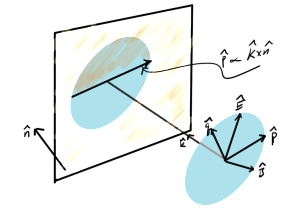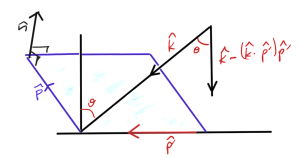[Click here for a PDF of this post with nicer formatting]
When computing the components of a polarized reflecting ray that were parallel or not-parallel to the reflecting surface, it was found that the electric and magnetic fields could be written as
\begin{equation}\label{eqn:gaFieldProjection:280}
\BE = \lr{ \BE \cdot \pcap } \pcap + \lr{ \BE \cdot \qcap } \qcap = E_\parallel \pcap + E_\perp \qcap
\end{equation}
\begin{equation}\label{eqn:gaFieldProjection:300}
\BH = \lr{ \BH \cdot \pcap } \pcap + \lr{ \BH \cdot \qcap } \qcap = H_\parallel \pcap + H_\perp \qcap.
\end{equation}
where a unit vector \( \pcap \) that lies both in the reflecting plane and in the electromagnetic plane (tangential to the wave vector direction) was
\begin{equation}\label{eqn:gaFieldProjection:340}
\pcap = \frac{\kcap \cross \ncap}{\Abs{\kcap \cross \ncap}}
\end{equation}
\begin{equation}\label{eqn:gaFieldProjection:360}
\qcap = \kcap \cross \pcap.
\end{equation}
Here \( \qcap \) is perpendicular to \( \pcap \) but lies in the electromagnetic plane. This logically subdivides the fields into two pairs, one with the electric field parallel to the reflection plane
\begin{equation}\label{eqn:gaFieldProjection:240}
\begin{aligned}
\BE_1 &= \lr{ \BE \cdot \pcap } \pcap = E_\parallel \pcap \\
\BH_1 &= \lr{ \BH \cdot \qcap } \qcap = H_\perp \qcap,
\end{aligned}
\end{equation}
and one with the magnetic field parallel to the reflection plane
\begin{equation}\label{eqn:gaFieldProjection:380}
\begin{aligned}
\BH_2 &= \lr{ \BH \cdot \pcap } \pcap = H_\parallel \pcap \\
\BE_2 &= \lr{ \BE \cdot \qcap } \qcap = E_\perp \qcap.
\end{aligned}
\end{equation}
Expressed in Geometric Algebra form, each of these pairs of fields should be thought of as components of a single multivector field. That is
\begin{equation}\label{eqn:gaFieldProjection:400}
F_1 = \BE_1 + c \mu_0 \BH_1 I
\end{equation}
\begin{equation}\label{eqn:gaFieldProjection:460}
F_2 = \BE_2 + c \mu_0 \BH_2 I
\end{equation}
where the original total field is
\begin{equation}\label{eqn:gaFieldProjection:420}
F = \BE + c \mu_0 \BH I.
\end{equation}
In \ref{eqn:gaFieldProjection:400} we have a composite projection operation, finding the portion of the electric field that lies in the reflection plane, and simultaneously finding the component of the magnetic field that lies perpendicular to that (while still lying in the tangential plane of the electromagnetic field). In \ref{eqn:gaFieldProjection:460} the magnetic field is projected onto the reflection plane and a component of the electric field that lies in the tangential (to the wave vector direction) plane is computed.
If we operate only on the complete multivector field, can we find these composite projection field components in a single operation, instead of working with the individual electric and magnetic fields?
Working towards this goal, it is worthwhile to point out consequences of the assumption that the fields are plane wave (or equivalently far field spherical waves). For such a wave we have
\begin{equation}\label{eqn:gaFieldProjection:480}
\begin{aligned}
\BH
&= \inv{\mu_0} \kcap \cross \BE \\
&= \inv{\mu_0} (-I)\lr{ \kcap \wedge \BE } \\
&= \inv{\mu_0} (-I)\lr{ \kcap \BE – \kcap \cdot \BE} \\
&= -\frac{I}{\mu_0} \kcap \BE,
\end{aligned}
\end{equation}
or
\begin{equation}\label{eqn:gaFieldProjection:520}
\mu_0 \BH I = \kcap \BE.
\end{equation}
This made use of the identity \( \Ba \wedge \Bb = I \lr{\Ba \cross \Bb} \), and the fact that the electric field is perpendicular to the wave vector direction. The total multivector field is
\begin{equation}\label{eqn:gaFieldProjection:500}
\begin{aligned}
F
&= \BE + c \mu_0 \BH I \\
&= \lr{ 1 + c \kcap } \BE.
\end{aligned}
\end{equation}
Expansion of magnetic field component that is perpendicular to the reflection plane gives
\begin{equation}\label{eqn:gaFieldProjection:540}
\begin{aligned}
\mu_0 H_\perp
&= \mu_0 \BH \cdot \qcap \\
&= \gpgradezero{ \lr{-\kcap \BE I} \qcap } \\
&= -\gpgradezero{ \kcap \BE I \lr{ \kcap \cross \pcap} } \\
&= \gpgradezero{ \kcap \BE I I \lr{ \kcap \wedge \pcap} } \\
&= -\gpgradezero{ \kcap \BE \kcap \pcap } \\
&= \gpgradezero{ \kcap \kcap \BE \pcap } \\
&= \BE \cdot \pcap,
\end{aligned}
\end{equation}
so
\begin{equation}\label{eqn:gaFieldProjection:560}
F_1
= (\pcap + c I \qcap ) \BE \cdot \pcap.
\end{equation}
Since \( \qcap \kcap \pcap = I \), the component of the complete multivector field in the \( \pcap \) direction is
\begin{equation}\label{eqn:gaFieldProjection:580}
\begin{aligned}
F_1
&= (\pcap – c \pcap \kcap ) \BE \cdot \pcap \\
&= \pcap (1 – c \kcap ) \BE \cdot \pcap \\
&= (1 + c \kcap ) \pcap \BE \cdot \pcap.
\end{aligned}
\end{equation}
It is reasonable to expect that \( F_2 \) has a similar form, but with \( \pcap \rightarrow \qcap \). This is verified by expansion
\begin{equation}\label{eqn:gaFieldProjection:600}
\begin{aligned}
F_2
&= E_\perp \qcap + c \lr{ \mu_0 H_\parallel } \pcap I \\
&= \lr{\BE \cdot \qcap} \qcap + c \gpgradezero{ – \kcap \BE I \kcap \qcap I } \lr{\kcap \qcap I} I \\
&= \lr{\BE \cdot \qcap} \qcap + c \gpgradezero{ \kcap \BE \kcap \qcap } \kcap \qcap (-1) \\
&= \lr{\BE \cdot \qcap} \qcap + c \gpgradezero{ \kcap \BE (-\qcap \kcap) } \kcap \qcap (-1) \\
&= \lr{\BE \cdot \qcap} \qcap + c \gpgradezero{ \kcap \kcap \BE \qcap } \kcap \qcap \\
&= \lr{ 1 + c \kcap } \qcap \lr{ \BE \cdot \qcap }
\end{aligned}
\end{equation}
This and \ref{eqn:gaFieldProjection:580} before that makes a lot of sense. The original field can be written
\begin{equation}\label{eqn:gaFieldProjection:620}
F = \lr{ \Ecap + c \lr{ \kcap \cross \Ecap } I } \BE \cdot \Ecap,
\end{equation}
where the leading multivector term contains all the directional dependence of the electric and magnetic field components, and the trailing scalar has the magnitude of the field with respect to the reference direction \( \Ecap \).
We have the same structure after projecting \( \BE \) onto either the \( \pcap \), or \( \qcap \) directions respectively
\begin{equation}\label{eqn:gaFieldProjection:660}
F_1 = \lr{ \pcap + c \lr{ \kcap \cross \pcap } I} \BE \cdot \pcap
\end{equation}
\begin{equation}\label{eqn:gaFieldProjection:680}
F_2 = \lr{ \qcap + c \lr{ \kcap \cross \qcap } I} \BE \cdot \qcap.
\end{equation}
The next question is how to achieve this projection operation directly in terms of \( F \) and \( \pcap, \qcap \), without resorting to expression of \( F \) in terms of \( \BE \), and \( \BB \). I’ve not yet been able to determine the structure of that operation.

